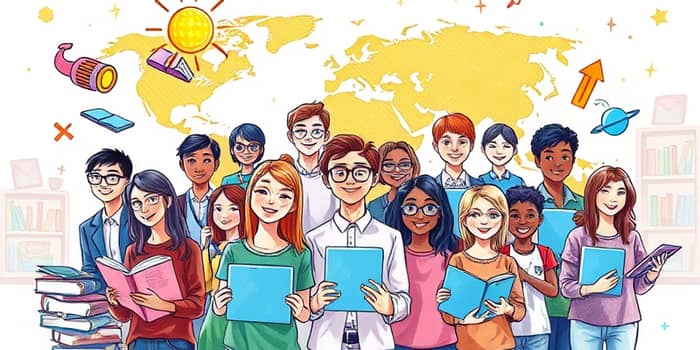
In an interconnected world, education stands as the cornerstone of sustainable progress, unlocking opportunities for individuals and societies alike. From early childhood classrooms to lifelong learning programs, the stakes have never been higher. As governments, philanthropists, and private investors navigate a $10 trillion market, the imperative to channel resources wisely becomes clear. This article explores why funding education today yields dividends for generations to come.
Spanning formal schools, vocational centers, and digital platforms, the education market has expanded into one of the most resilient global industries. As of 2025, the global education sector is valued at nearly $10 trillion, a figure projected to accelerate toward $10 trillion by 2030. Unlike volatile commodities or cyclical technology ventures, education remains shielded from many market shocks. Even amid recessions, families and governments uphold their commitments, ensuring that economic downturns, spending on education continues uninterrupted.
Key growth areas include Early Childhood Education and Workforce Education, driven by shifting demographics, the digitization of learning, and an urgent need for upskilling. Global markets report increased participation rates in emerging regions as more students gain access through online and community-based programs. Simultaneously, digital innovations and vocational training platforms attract significant investor interest, further fueling the sector’s upward trajectory.
Beyond individual advancement, robust education systems catalyze societal transformation. Research shows that education drives economic growth, productivity, poverty reduction, positioning nations on a trajectory toward prosperity. As literacy rates climb and critical thinking skills sharpen, communities experience lower crime rates, healthier populations, and increased civic participation. These benefits extend far beyond test scores, creating a virtuous cycle where educated citizens invest back into social infrastructure and democratic institutions.
Moreover, the long-term advantages of high educational attainment go deeper than raw economic output. Studies link access to quality education with significant improvements in mental and physical health, underscoring the higher educational attainment correlates with better health. When leaders, entrepreneurs, and workers possess the skills to innovate, societies are better equipped to tackle challenges, from climate change to public health crises, cementing education’s role as a strategic policy priority worldwide.
The financial underpinning of education intersects public budgets, private capital, and philanthropic grants. In 2025, private equity investment rebounded strongly after dipping to a three-year low of $4.60 billion in 2023–24, signaling renewed confidence. Meanwhile, impact investing assets under management have swelled from approximately $715 billion in 2020 to estimates as high as $2.1 trillion, according to the International Finance Corporation. Despite this momentum, the world still confronts a $2.5 trillion annual funding gap needed to achieve Sustainable Development Goal 4 by 2030.
In the United States, the Department of Education supports 26 million low-income K–12 students under Title I, along with 9.8 million rural learners, 7.4 million students with disabilities, and 5 million English Language Learners. This substantial public investment ensures broad access, but the private sector brings capital, operational expertise, and technological innovation into classrooms and online platforms. Aligning these resources around clear objectives remains a critical challenge.
Key focus areas for funders and policymakers include:
Effective school leadership lies at the heart of educational excellence. Principals and administrators shape curricula, mentor teachers, and cultivate supportive learning environments. Research demonstrates that strong leadership can account for up to 25% of a school’s impact on student achievement, making it a powerful lever for change. Equity-focused practices—such as inclusive hiring, bias-aware discipline policies, and targeted resource allocation—are essential to ensure every learner has a fair chance to succeed.
Successful strategies often involve rigorous teacher evaluation, instructional coaching, data-driven learning, and collaborative professional networks. By prioritizing culturally responsive pedagogy and strengthening community ties, schools can mitigate achievement gaps that disproportionately affect low-income students and students of color. Investing in leadership development not only improves academic outcomes but also fosters resilient school cultures where all stakeholders thrive.
Today’s learners must navigate complex financial landscapes and dynamic job markets. Embedding budgeting, debt management, investing, and planning into school curricula builds foundational life skills that pay dividends across a lifetime. Without these competencies, individuals risk crippling debt, inadequate retirement savings, and limited economic mobility. Early exposure to financial education empowers young people to make informed decisions, fostering a generation of fiscally responsible adults.
Simultaneously, career readiness initiatives are evolving to meet the demands of emerging sectors. Governments and businesses are increasing support for vocational and technical education, ensuring students master skills directly aligned with high-growth industries such as renewable energy, technology, and advanced manufacturing. Collaborations between educational institutions and employers create apprenticeships, internships, and certification pathways, bridging the gap between classroom learning and real-world application.
Technological advancement continues to reshape how education is delivered and accessed. After initial caution, schools and policymakers are embracing generative AI and other tools to personalize learning, automate administrative tasks, and provide real-time feedback. Digital platforms extend the reach of quality instruction to rural or underserved communities, breaking down geographic and socioeconomic barriers.
Nonetheless, leaders recognize that technology is not a panacea. There is a renewed emphasis on foundational literacy and numeracy—often termed “back to basics”—while digital solutions are deployed to supplement, not supplant, human-driven pedagogy. Blending traditional teaching methods with cutting-edge innovation creates a scalable model that adapts to local needs, ensuring inclusive and effective educational experiences.
Despite remarkable progress, significant obstacles remain in the global quest for equitable education. Persistent funding shortfalls, uneven access to quality schooling, and the disruptive impact of global crises test the resilience of education systems. Addressing these challenges requires coordinated action across sectors and borders.
When viewed through an investment lens, education delivers both tangible economic growth, productivity and far-reaching social returns. Individuals benefit from higher lifetime earnings, improved health outcomes, and greater civic engagement. Communities experience lower crime rates, stronger social cohesion, and enhanced innovation capacity. At a macro level, nations with educated workforces demonstrate greater competitiveness, resilience to economic shocks, and the agility to adapt to shifting industry landscapes.
Realizing these benefits depends on balanced public and private investment. While governments guarantee universal access and uphold equity standards, private entities inject agility, innovation, and operational efficiencies. public and private investment are needed to finance infrastructure, develop teacher talent, and scale digital platforms. By collaborating across sectors, stakeholders can bridge funding gaps and create sustainable models that amplify education’s transformative power.
The following metrics underscore the scale and urgency of education investment worldwide.
Staying ahead in education requires continuous vigilance and strategic innovation. Stakeholders must explore new modalities, partnerships, and policies to unlock education’s full potential.
Education transcends the classroom, acting as the engine of social mobility, innovation, and shared prosperity. In a world beset by complex challenges, allocating resources wisely to expand access, improve quality, and foster systemic resilience is imperative. Every investment made today has the potential to unlock human potential, drive sustainable growth, and build more harmonious societies.
We stand at a crossroads: by embracing collaborative funding models, prioritizing equity, and championing innovation, we can ensure that every learner benefits from the transformative power of education. Investing in education yields lifelong returns, lighting the path toward brighter futures for individuals and communities across the globe.
References













